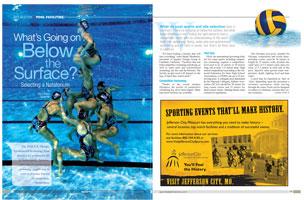
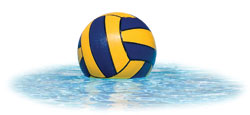 What do pool sports and site selection have in common? There's a lot going on below the surface, and what looks effortless is not. Finding the right venue to host a competition starts with an understanding of the sport itself. Yes, swimming, diving, water polo and synchronized swimming are all held in pools, but that's all they have in common.
What do pool sports and site selection have in common? There's a lot going on below the surface, and what looks effortless is not. Finding the right venue to host a competition starts with an understanding of the sport itself. Yes, swimming, diving, water polo and synchronized swimming are all held in pools, but that's all they have in common.
"It's hard finding a facility that will have everything," notes Randy Mendioroz, president of Aquatic Design Group in Carlsbad, California. "Facilities that can hold competitive swimming and diving, as well as water polo and synchronized swimming, are few and far between. The facility people need will depend on the type of sport they want to host."
Competitive Swimming
Thanks to the recent summer Olympics, the profile of competitive swimming has never been higher. Many top-notch facilities are available.
Pool size
FINA, the international governing body for five water sports, including competitive swimming, requires a competition-level pool to be 25 meters or 50 meters long, and at least 1.35 meters deep. High school competitions (according to the National Federation for State High School Associations, or NFHS) can use a 25-meter-long pool. A collegiate pool sanctioned by the National Collegiate Athletic Association (NCAA) should be 50 meters for long course swims and 25 meters for short-course swims. Starting blocks must conform to regulations.
The Olympic-size pool, suitable for Olympic competition and world championship events,must be 50 meters in length by 25 meters wide, divided into eight lanes of 2.5 meters each, plus two areas of 2.5 meters at each side of the pool. Specific rules govern water temperature, depth, lighting level and lane ropes.
A pool may be classified as 'fast' or 'slow,' depending upon the resistance a swimmer encounters while moving through the water. Pools can be designed to reduce or eliminate currents that create resistance.
Officiating
Pools used for competitive swimming where records are expected to be set have officiating equipment, which records the elapsed time of each swimmer and determines relative place in a race. A number of officials may be necessary: start judges, stroke judges, turn judges, etc.
"At any level of competition, the most important thing is to run a technically flawless event," says Dean Ekeren, the national events director of USA Swimming, the sport's national governing body. "You can have all the great amenities, but if you don't get the times and placements right, you're doing a disservice to the athletes. Beyond that, you want spectators, athletes, everyone to generally have a good time, and you want all parties to come out financially satisfied."
Competitive Diving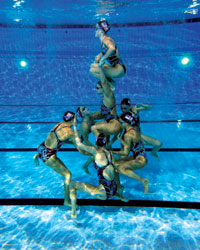 Competitive diving is divided into springboard diving and platform diving. Springboard events include the one-meter and three-meter boards, while platform diving is done from the five-meter, seven and a half-meter and the 10-meter platforms (also called towers).
Competitive diving is divided into springboard diving and platform diving. Springboard events include the one-meter and three-meter boards, while platform diving is done from the five-meter, seven and a half-meter and the 10-meter platforms (also called towers).
The number of boards and towers needed will depend upon the level of competition and number of divers. High school diving generally uses the springboard. Platform diving starts on the collegiate level. In high school and college, swimming and diving are grouped under one heading, with teams traveling and competing together; at higher levels, competitions are held separately.
Pool Dimensions
The diving area of a water sports facility should be separated from the competitive swimming area. The space of that area, and the water depth under each board or platform, are specified by the governing bodies.
Water Polo
Water polo is played officially on the high school level and up, although younger participants enjoy club and recreational league play.
Field of Play
The dimensions of the water polo course will vary according to the governing body; FINA rules state that distance between the goal lines is 30 meters for men, and 25 meters for women. The width of the field of play is 20 meters, and the water depth no less than 1.8 meters (and preferably two meters). Lines of play are marked in specific colors.
Other Equipment
Regulations govern the goal, location of the game clock, placement of judges, minimum lighting and more. Regulations may vary according to the governing body.
Synchronized Swimming
In the U.S., synchronized swimming draws participants from elementary school age through adulthood, with different organizations setting rules for their levels of competition.
Pool Requirements
"The depth, of course, is probably the major factor for us," says Taylor Payne of the United States Synchronized Swimming, the national governing body.
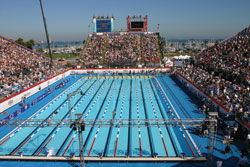 On the national level, for the figure section of competition, FINA states there must be two areas, each of which is 10 meters long by three meters wide. Each area must be close to a wall of the pool with the 10-meter side parallel to and not greater than 1.5 meters from the pool wall. One of these areas is to be a minimum depth of three meters, while the other must have a minimum depth of two and a half meters. For the routine area of competition, a minimum area of 12 meters by 25 meters is required; this must be within an area of which 12 meters by 12 meters must have a minimum depth of two and a half meters. (Synchronized swimming on the Olympic and World championship levels requires a larger area). Pool markings are also specified.
On the national level, for the figure section of competition, FINA states there must be two areas, each of which is 10 meters long by three meters wide. Each area must be close to a wall of the pool with the 10-meter side parallel to and not greater than 1.5 meters from the pool wall. One of these areas is to be a minimum depth of three meters, while the other must have a minimum depth of two and a half meters. For the routine area of competition, a minimum area of 12 meters by 25 meters is required; this must be within an area of which 12 meters by 12 meters must have a minimum depth of two and a half meters. (Synchronized swimming on the Olympic and World championship levels requires a larger area). Pool markings are also specified.
Facilities specifically for synchronized swimming have underwater and poolside loudspeakers allowing swimmers to hear their music and stay in sync, whether their heads are submerged or above the surface. Rules govern the lighting levels, water temperature, etc.
Across the Board
Depending upon the event, a facility may need the following:
Access to officials: Judging/officiating of competitive water sports requires specialized expertise, and officials' time should be booked in advance. Consult local governing bodies about availability of officials and how many are needed.
Seating and parking: Have appropriate seating and parking areas for spectators, athletes and others. ADA considerations apply.
Conveniences: Showers, lockers and rest rooms for athletes are necessary, with separate rest rooms for spectators if possible. Places where teams can sell souvenirs or refreshments can assist with fund raising.
Competition amenities: Scoreboards and public address systems are necessary.
Emergency facilities: All water sports facilities should have lifeguards.
Media-friendly: Media coverage is easier in facilities featuring a working press box with amenities like electricity, phones and wi-fi.
Don't Get In Over Your Head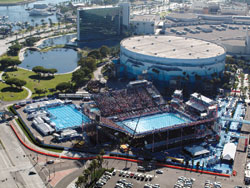 With so many high-quality water sports facilities available, an event planner can get carried away when picking a venue, says Steve Comstock, president of RenoSys, Inc. in Indianapolis, Indiana.
With so many high-quality water sports facilities available, an event planner can get carried away when picking a venue, says Steve Comstock, president of RenoSys, Inc. in Indianapolis, Indiana.
"Make sure you're spending your dollar wisely," Comstock says. "If you don't need the big TV screen, if you don't need the press box, if you don't need the diving facility, don't go for a place that has all those amenities. Don't get caught up in the hype of a prestigious natatorium. You need to make a list of important necessities, and you want to compare that to the facility you're considering. That will allow you to pick the facility that suits your needs."
Making a Splash
It's your event, and the choice of sink or swim is up to you. Make sure you've tested the waters adequately before you take the plunge.

